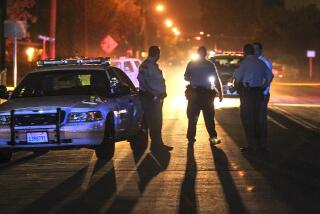Q&A: Investigating cold cases takes patience and determination
In March, the Los Angeles County Sheriff’s Department announced charges in the killing of Brenda Sierra, an East Los Angeles teenager who vanished while on her way to school in 2002.
Investigators believe the 15-year-old was kidnapped, taken to a gang hangout and sexually assaulted. She was then beaten to death in a vacant lot. Her body was found dumped in the San Bernardino National Forest. Authorities have filed charges against a 27-year-old woman believed to be associated with the killing, and she is being held without bail. Investigators have identified at least three additional suspects.
The Times sat down with Det. Larry Brandenburg, a 30-year veteran of the department and the lead investigator on the case, to talk about unsolved homicides and how he approaches investigations.
How does the Sheriff’s Department unsolved unit work?
We’ve hired back retired homicide [investigators] who review the cases. There’s an actual criteria — they come up with a solvability rating. And if it’s medium to high, then it goes to the unsolved lieutenant and he assigns it to an unsolved investigator. Or we can get a phone call come in on an old case with a new lead. And that case will get pulled out of the library.
What makes for a higher solvability rating?
If there’s witnesses still alive, obviously, evidence is still all intact. Those are big things when it comes to court. That’s one thing when you go to present these old cases to the district attorney’s office, they want to know: Are these witnesses alive? Do you know where they are? Have you talked to them? Because obviously without witnesses it’s not going to go anywhere.
And now we also have a lot of technological advances, in DNA, for example — it’s come a long way and it’s evolving all the time.
How many people work these cases?
We used to have … over 10 full-time investigators at one point, but right now we’re down to about three or four because of attrition and our department is so short on people right now. We’re in this big push to hire.
Is the term “cold case” something investigators don’t like? How do you feel about that term?
I think maybe it’s a term that probably, maybe got picked up from the media, I don’t know. We always traditionally called it unsolved.... Homicides are never closed out unless they’re solved and prosecuted, the bad guys put away. The ones that aren’t solved … they sit dormant, obviously, unless some new information comes in or new evidence that causes them to be reopened or reinvestigated, if you will.
What makes a “cold case”? Is there a specific time period?
There’s no specific time period.... When a case sits because there’s nothing to do on it, there’s just nothing workable, it sits and it gets older and older and older. Obviously it becomes more difficult with the passage of time, especially if you have a couple decades go by. People move, people die, you can’t find them. It presents a lot of unique challenges, as opposed to a fresh homicide.
What should families with unsolved cases do?
They have got to keep on the police. We’re overwhelmed with cases, especially the old ones. If there’s no one calling on that case — I mean we have this safety net … of guys that review them now. We do catch some that are workable that get reassigned and reopened and investigated. But without that and without the family ... wanting to know what’s going on, what will happen, it sits because we don’t have the resources.
What philosophy informs the way you investigate cases? Is there some sort of mantra that you go by?
Every murder is different, obviously, but you look at the people who are involved and what kind of person they are and what kind of life did they live, and you just look at it logically, what makes sense. Human beings are creatures of habit for the most part. Our job, a lot of times, we figure out pretty easily who the person is and why they did it. It’s proving it is the hard part.
Is there a case that’s kind of stuck with you over the years, either solved or unsolved?
The case I have now. Brenda Sierra. When it first happened in 2002, her family told our department that this wasn’t like their daughter. She’s very responsible, something happened. It was just such unusual circumstances for this girl.
[The San Bernardino County Sheriff’s Department] did a lot of work on the case. They really identified a lot of the people involved. It was one of those cases that with the passage of time, and guys who were transferring out of the unit, it got handed over to different detectives over the years.
Finally in 2008, we got the case, and we’ve been working it ever since. We’ve put a lot into this case. I can’t go into the details — a lot went into it. Finally we’re getting some success for the family.
What was it like to let the family know you were getting close to these arrests?
It was very rewarding to tell them. They’re nice people. Great people.
I guess that’s the best part of the job?
It is. I bet it’s tough for them, it’s a bittersweet thing for them, I’m sure. But I think they’re glad we’re finally getting the people and holding them accountable for what they did.
Why did this case stand out?
She was totally innocent, this girl. She didn’t deserve this. It’s a shame what happened. I mean, we work hard on all of them, we don’t “play God,” if you will, but obviously there are ones that stand out.
I know the case took a long time. How did you keep motivated?
I think you just remind yourself what happened and how terrible it was. It keeps you motivated. I mean, I have kids.... It would be tough.
More to Read
Start your day right
Sign up for Essential California for news, features and recommendations from the L.A. Times and beyond in your inbox six days a week.
You may occasionally receive promotional content from the Los Angeles Times.







